An imperial cathedral; one of the largest cathedrals in EuropeThe very large cathedral at Speyer, started by the Salian emperors, was a testatment to the power of these rulers and became one of the most important places in the medieval German empire. The cathedral was begun about 1025-30 under Emperor Conrad II and completed under Henry IV. Four Salian emperors and their wives are buried here. The cathedral met hard times over the years with it being almost in ruins in the 17th and 18th centuries. In the 19th century it was restored with the western end rebuilt according to the original concept. |
 |
The westwork--as tall as the nave(See below for angled and side views views.) One of the important developments in Carolingian architecture was the development of the westwork or a combination of towers, including a separate devotional space in upper chambers, at the west end for a church patron or an emperor. "The main function of the westwork was to draw attention to the emperor or ruler, even if he was not there in pweson. The westwork embodied the power of the state and rthe sacrosanct nature of the ruler. The westwork church encompasses two distinct areas of significance within in: firstly, the actual church to the east dedicated to the saints, the Ecclesia triumphans, and secondly, the bulwark-like westwork, symbol of the Ecclesia militans, the place of the ruler as protector of the church" (Toman 36). Speyer Cathedral continues and builds on that tradition begun in the Carolingian period so that forms begun then are made grander amd more complex. |
| |
|
Clearly demarcated facadeThree bays, defined vertically, each with a portal into the marthex, and three registers are clearly indicated. The second register includes windows into the upper chamber and a type of rose window with the symbols of the four evangelists carved in the corners--clockwise, the eagle (St. John), the angel (St. Matthew), the winged ox (St. Luke), and the winged lion (St. Mark). Striped patterns in red sandstone embellish the facade.
|
 |
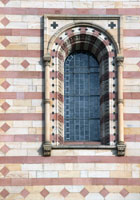 |
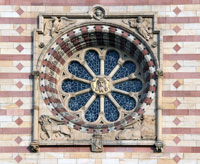 |
| |
|
Octagonal tower over the central bay of the narthex |
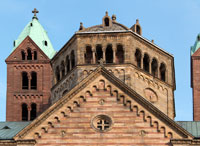 |
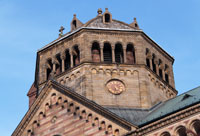 |
| |
|
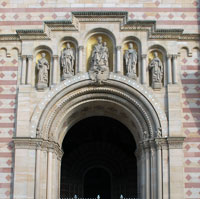 |
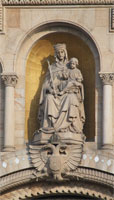 |
Dedicated to Maria, the church has above the main entrance a central statue depicting the Virgin and Child.
(I photographed many details of the sculpture but unfortunately the officials have covered all sculpture with netting--against the pigeons--which destroys the effect of any closeup.) |
| |
|
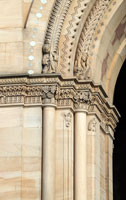 |
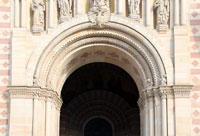 |
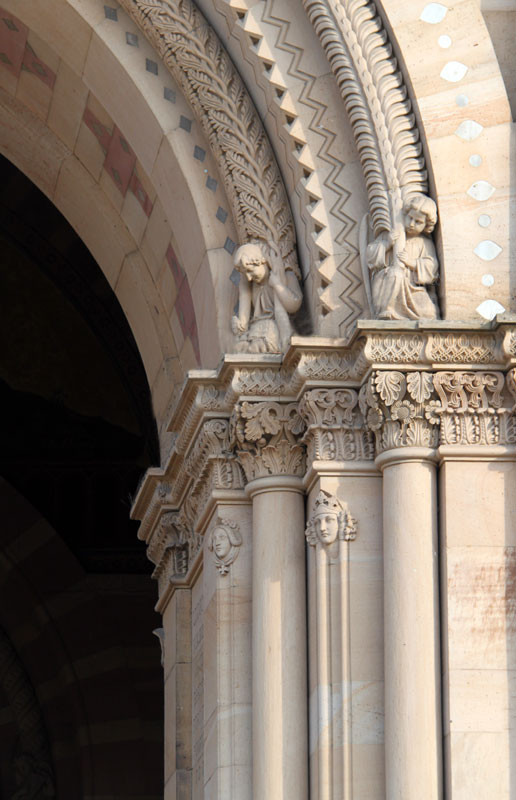 |
| |
|
 |
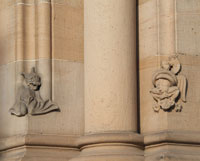 |
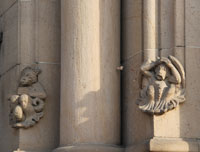 |
| |
|
The westwork |
 |
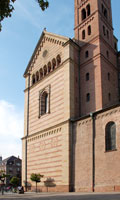 |
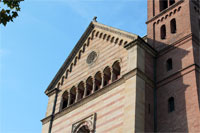 |
| |
|
|
 |
 |
| |
|
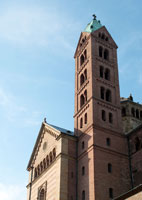 |
|


 Click here to return to index of art historical sites.
Click here to return to index of art historical sites.
 Click here to return to index of artists and architects.
Click here to return to index of artists and architects.
 Click here to return to chronological index.
Click here to return to chronological index.
 Click here to see the home page of Bluffton University.
Click here to see the home page of Bluffton University.
